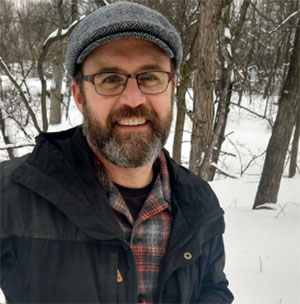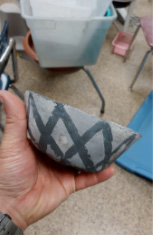

UMN Crookston students experience hands-on learning opportunities in the Pottery Design and Techniques course.
Associate Professor Students on the campus of the University of Minnesota Crookston are actively engaged in hands-on learning throughout the year. Eric Castle, associate professor in the Agriculture and Natural Resources department, has taken it to heart as he sought to show students in his Art 1353: Pottery Design and Techniques course they can make pottery from materials found in nature.
Castle learned the ancient technique of the Anasazis, a Native American people that inhabited the American southwest in modern day Colorado, Arizona, Utah, and New Mexico, during a class he had taken last summer. One of the teachers Castle learned from has been doing pottery since the 1970s and was contracted by the Bureau of Land Management.
Castle brought back his teacher’s favorite clay and it became the root of one of the class projects this semester. The process was an elaborate one as Castle taught his students how to utilize materials around them.
“We brought the clay back (to Crookston) in a bucket with chunks of this lightish-gray colored clay,” Castle said. “From there we needed to process it and did so by going out in the Nature Nook and finding a good round rock from the landscaped areas to grind the clay and turn it into a fine powder. After mixing it to the right consistency, we made coil pots and let those dry.”

When the pots were dry, Castle and his class focused on painting the pots using a technique known as black and white style. “There is a lot of evidence of white-looking pottery and the paint is black. To get that black color, we used paint made from Rocky Mountain Bee Plant.” After the pots were painted, the focus became firing the clay to finalize the project. In order to stick with the ancient techniques of the Anasazi people, Castle needed to find sandstone and an area where the class could dig a hole for an underground kiln. With the help of staff in the Facilities Department at the UMN Crookston, they were able to find a location on campus to dig a pit about 14 inches deep, three feet wide, and eight feet long. Ideally this pit would be lined with sandstone slabs, however, sandstone doesn’t occur naturally in this area. Fortunately, facilities saved pieces from around the windows of the old student center which were made of sandstone. Castle joked, “They stored the pieces for 30 years and apparently were waiting for a pottery class to come around.”
Now that he had a location, the class had one final step of the project as they fired their clay pots in the underground kiln. “We came out one Sunday and got the fire started. To create those oxygen-starved conditions, you heat the fire until its peak temperature and right at that point you smother the fire. We took the dirt we excavated out of the pit and buried the kiln with all of the pottery inside and let that bake and cool overnight. The next day we dug it out and unearthed the pottery the students made.”

Castle was very pleased with the project and is excited to teach his future classes the same style of pottery. One thing he is looking forward to is finding local clay and people who know more about the ancient traditions of the Red River Valley region.
Castle believes the project met his ultimate goal of helping show students they can make things with materials found right around them. Castle remarked, “You don’t need fancy clay, you don’t need a fancy kiln. It is just this very primal way of connecting with the place you are. If you can find clay around you, that is a part of the place you live, you can take that clay and make something beautiful or useful or something beautiful and useful.”


